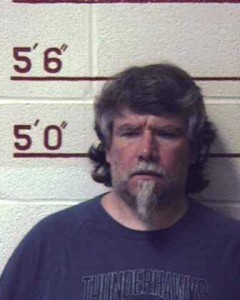
CLEARFIELD – A jury deliberated for approximately one hour Tuesday evening before finding a man guilty of all charges for providing the heroin that resulted in another man’s death back in July of 2014.
Mark D. Shaffer, 46, of Reynoldsville was found guilty of manufacture, delivery or possession with intent to manufacture or deliver; drug delivery resulting in death; involuntary manslaughter; recklessly endangering another person; and intentional possession of a controlled substance.
The charges stemmed from July 18-19, 2014 when Shaffer provided the victim who was highly intoxicated with a stamp bag of heroin at the campground at the Curwensville Moose. It resulted in the victim’s overdose death, according to previously published GANT news reports.
Dr. Harry Kamerow, the pathologist who conducted the autopsy on the victim on July 21, 2014, took the stand first when the commonwealth continued presenting its case Tuesday. Kamerow said he was contacted by Clearfield County Coroner Michael Morris to perform the autopsy, which was done at the Mount Nittany Medical Center.
Kamerow said he was advised it was believed the victim had suffered a drug overdose and possibly on heroin. He explained that heroin quickly metabolizes into morphine via 6-monoacetylmorphine.
As a result, Kamerow said it was important for the primary blood sample to be from that drawn closest to the time of the use of heroin. For this case, he said Morris retrieved the blood and urine samples from Clearfield Penn Highlands Hospital to be sent for laboratory testing at NMS Labs.
According to Kamerow, the pre-mortem blood screening showed an elevated level of alcohol in the victim’s system. In fact, he said that the victim had a blood-alcohol content level of .257.
Kamerow said that the pre-mortem blood screening also showed the presence of both 6-monoacetylmorphine and morphine; medications administered during the victim’s treatment; and Naloxone, which is used to antagonize a drug overdose.
Kamerow said that the post-mortem blood screening showed the presence of morphine in the victim’s system. He noted that while the victim remained alive for several hours, the heroin converted into 6-monoacetylmorphine and then into morphine.
Kamerow concluded that if the victim had only consumed alcohol until reaching the BAC of .257, he would have recovered from it. He said the cause of death was concluded to be a multi-drug overdose due to the presence of both alcohol and heroin; however, the primary principle resulting in the victim’s death was heroin.
Trooper Justin Jones, a criminal investigator with the Clearfield-based state police, testified last for the commonwealth. He said on July 19, 2014 he was assigned to investigate a suspected drug overdose that had occurred during the early-morning hours.
Upon arrival at the hospital, Jones said he spoke with Dr. Clifford Neal and the victim’s girlfriend and family members. He also observed the victim in the hospital and then contacted both Morris and the Clearfield County District Attorney’s office.
Jones said he obtained consent to search the vehicle that belonged to both the victim and his girlfriend at the time. He said during the search, he was looking for any drug-related items but only found empty beer cans. A search of the campsite, Jones said only turned up more empty beer cans and nothing related to drugs.
After speaking with the manager, bartender and the victim’s friends at the Curwensville Moose, Jones identified Shaffer as the person of interest in his investigation. He interviewed Shaffer with Trooper William Mostyn, also a criminal investigator with the Clearfield-based state police.
During that interview Aug. 6, 2014, Jones said Shaffer admitted he was with the victim who wanted to use heroin after they left the Curwensville Moose Lodge and returned to their campsite during the early-morning hours of July 19, 2014.
According to Jones, Shaffer said he initially told the victim no but eventually gave him a stamp bag of heroin. He said Shaffer told him the victim leaned over and snorted it from a container on his [Shaffer’s] knee but exhaled and joked about not doing it right.
Jones said Shaffer told him the victim then ingested heroin by licking it from his finger. Within a matter of seconds, Shaffer told him the victim was unresponsive, and he went to get the victim’s girlfriend who was asleep in the camper.
Jones said Shaffer told him that once he observed the ambulance arriving at the campsite, he “stepped into the shadows.” Jones said Shaffer didn’t remain at the scene to assist and went to hide instead.
District Attorney William A. Shaw Jr. then played a significant portion of Jones’ interview with Shaffer for the jury. On the audio recording, Shaffer told Jones that he had 10 stamp bags of heroin that night. He used eight of them, gave one to the victim and saved one for himself.
When asked by Jones, Shaffer said he didn’t feel responsible for the victim’s death. He said the victim was 41 years old, it was his decision and “it’s the chance you take.” However, Shaffer also told Jones that if he could go back, he wouldn’t have given “his buddy” the heroin.
On Tuesday afternoon, Shaffer testified in his own defense. He told the jury he was a long-time heroin addict and developed the addiction after being prescribed opiates for injuries.
Shaffer said he and the victim had been friends for more than 20 years and drinking and doing drugs played into their lives. On the night of July 18-19, 2014, Shaffer said there wasn’t any discussion about them doing drugs before the victim and his girlfriend picked him up.
Shaffer said the victim consumed alcohol before going to the Curwensville Moose Club and more while there. Shaffer said he didn’t drink any alcohol and was only there socially. When they returned to their campsite, Shaffer said the victim repetitiously asked for some heroin.
Shaffer said he didn’t feel the victim needed the heroin. He also said he wanted the heroin for himself, as he’s an addict who uses 10 stamp bags three times a day. Shaffer said he used eight stamp bags while inside the vehicle at the campsite and would have used all 10 if the victim hadn’t taken two from him.
Shaffer said that the victim used one stamp bag, and he picked up the other and placed it in his pocket. He said when the victim tried to snort the heroin he exhaled and distributed it about the container. Shaffer said the victim then licked an amount of heroin from his finger.
Under cross-examination, Shaw asked Shaffer if he was now claiming the victim stole the heroin from him. Shaffer replied, “If that’s what you want to call it” and claimed he told the victim no and he took it anyway without his permission.
Shaw said that when asked during an interview with state police if he gave or sold the heroin to the victim, Shaffer said he gave it to him. Shaffer argued that state police gave him two choices, and because he didn’t sell the heroin to the victim, he replied that he gave it to him.
Shaffer said when they returned to camp from the Curwensville Moose Club the victim was drunk. Shaffer said he had heroin on him and got inside the vehicle to use it. Shaffer said he’d prepared heroin to inject when the victim reached in, took two stamp bags and left.
Shaffer said when the victim returned to the vehicle, he entered the passenger’s seat and proceeded to open a stamp bag of heroin. Shaffer said at that point, he wasn’t telling the victim he wasn’t allowed as he was 41 years old.
While under questioning by Shaw, Shaffer claimed he didn’t leave as emergency personnel arrived at the scene. He argued that he only “stepped into the dark behind a tree” and was still just feet from the scene.
But when asked, Shaffer admitted that he didn’t assist emergency personnel by providing information about what happened to the victim.
Later under direct examination by his attorney, Shaffer claimed that during his interview with state police, he was trying not to “bad mouth” his buddy and to do “damage control,” which is why he didn’t provide elaborate answers.
Shaw later disputed this argument from Shaffer, saying Shaffer was only looking out for himself with the victim being dead.
In closing, Shaffer’s attorney Michael Marshall argued that the big issue for the jury to decide was whether or not Shaffer actually gave the heroin to the victim. He said if Shaffer didn’t give the victim the heroin, the most he was guilty of was possession of a controlled substance.
Marshall argued that Shaffer’s story made more sense. “You don’t say ‘no, no, no’ and then turn around and just give it [the heroin] to him,” he said. Marshall pointed out that Shaffer was addicted, used multiple times a day and wanted the heroin for himself.
Marshall also argued that the state troopers designed an interview to get Shaffer to admit that he gave the heroin to the victim. He said they wanted to hear the magic words of “give” or “gave” and didn’t ask the right questions.
“The trooper didn’t search the camper for drugs or paraphernalia,” he said. “They didn’t want the facts. It’s a huge oversight that should cause reasonable doubt … you can’t ask the jury for a conclusion based on maybes or mights when you have the burden of proof.”
Marshall ended his closing by asking the jury if it would be “fair” to apply the statutes for drug delivery resulting in death to a case involving two “life-long buddies.”
Shaw countered, arguing that Marshall asked the jury to consider the case differently because Shaffer and the victim were buddies. He pointed out that Shaffer “stepped into the shadows” and abandoned his “life-long buddy” when he was in distress
He said the commonwealth didn’t have the burden of proving how the victim ingested the heroin. He said it was pretty straightforward and came down to the fact that Shaffer gave heroin to the victim who is now dead because of it.
“It wasn’t the booze that killed him,” Shaw argued. “We heard testimony from the pathologist who said that without the heroin, he wouldn’t have died. And, the state police asked Mark Shaffer straightforward questions, and he said, ‘I gave him the heroin.’”
When asked after the verdict, Marshall said he believed there were significant legal issues that could be raised on an appeal. He declined to comment any further on the outcome of the trial.
Shaffer will be scheduled for sentencing within 60 days. Shaw wasn’t able to comment on the potential length of Shaffer’s sentence. He said there will be a pre-sentence investigation, and Shaffer’s prior criminal history will be a factor in his sentence.
Shaw said he was very satisfied with the verdict and gave credit to the state police and the coroner. He also said he was proud of the jury and felt this case will send a message that if you provide someone with heroin and they die, you will be held responsible.




